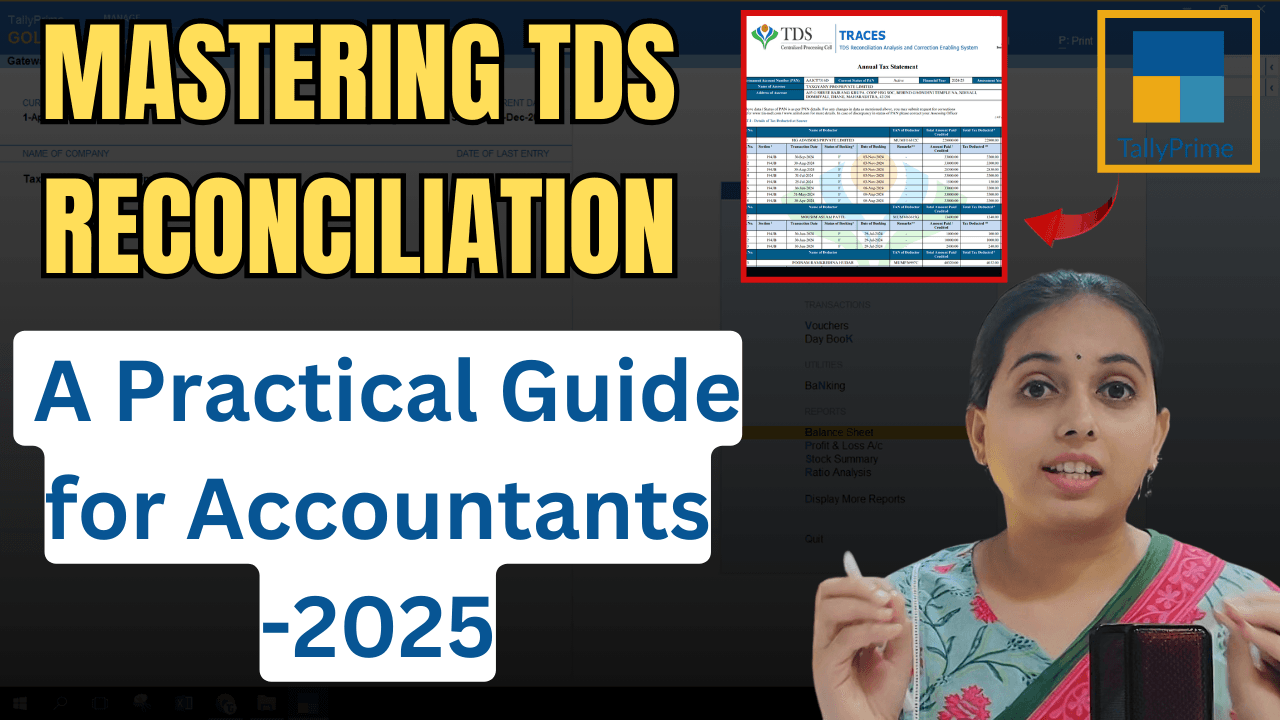Mastering TDS Reconciliation
TDS (Tax Deducted at Source) reconciliation is a vital aspect of accounting, ensuring that all tax deductions are accurately recorded, reported, and matched with the corresponding payments. For accountants managing company accounts, mastering this process is essential for maintaining compliance with tax laws and avoiding penalties.
In this detailed guide, we’ll walk you through the concept of TDS reconciliation, the tools you’ll need, and the step-by-step process for achieving accurate records. By the end of this blog, you’ll be equipped with practical knowledge to streamline TDS reconciliation for your organization or clients.
What is TDS Reconciliation?
TDS reconciliation is the process of verifying the accuracy of tax deductions reported by a deductor (e.g., a company) with the records maintained by the Income Tax Department. This involves matching:
- TDS deducted and deposited: Ensuring that the tax deducted from payments such as salaries, contractor payments, or professional fees is correctly deposited with the government.
- Form 26AS: Confirming that the deductions appear accurately in the deductee’s Form 26AS, which serves as a consolidated tax credit statement.
- Books of accounts: Cross-checking the entries in the company’s accounting software (e.g., Tally) with tax filings and bank records.
Why is TDS Reconciliation Important?
TDS reconciliation is crucial for several reasons:
- Compliance: Ensures adherence to tax laws and regulations.
- Avoid penalties: Prevents penalties for discrepancies between reported and actual deductions.
- Credibility: Maintains the organization’s reputation with clients, employees, and tax authorities.
- Accurate reporting: Helps avoid mismatches during audits or assessments.
Tools Required for TDS Reconciliation
To perform TDS reconciliation effectively, you’ll need:
- Accounting Software: Software like Tally ERP or QuickBooks for maintaining accurate records of transactions.
- Form 26AS: Downloadable from the Income Tax Department’s e-filing portal, this form shows all TDS credited to the deductee’s account.
- TRACES Portal: For accessing TDS certificates (Form 16/16A), filing corrections, and downloading TDS data.
- Bank Statements: For verifying TDS deposits and payments.
Step-by-Step Guide to TDS Reconciliation
For better understanding watch this video – https://youtu.be/qhUvg16tXwo
Step 1: Collect and Organize Data
Gather all relevant documents and records, including:
- TDS challans (tax payment receipts)
- TDS certificates (Form 16/16A)
- Bank statements
- Invoices and payment records
Step 2: Verify TDS Deductions
- Ensure that TDS is deducted at the correct rate for each transaction as per the applicable Income Tax Act provisions.
- Check that deductions are made on eligible payments such as salaries, rent, professional fees, or contractor payments.
Step 3: Cross-Check with Form 26AS
- Download Form 26AS from the Income Tax Department’s portal.
- Match the TDS entries in Form 26AS with the deductions recorded in your accounting software.
Step 4: Reconcile Books of Accounts
- Verify that the TDS entries in the books of accounts align with the payments made to the government.
- Use accounting software to trace discrepancies and correct them.
Step 5: Address Discrepancies
If you identify mismatches:
- Missing entries: Record the missing deductions in your accounts.
- Incorrect amounts: Amend the entries in Form 26AS through the TRACES portal.
- Unmatched payments: Verify bank challans and ensure timely correction of errors.
Step 6: Generate and Submit TDS Returns
- File the quarterly TDS returns (Form 24Q for salaries, Form 26Q for other payments) through approved software or government portals.
- Verify acknowledgments to confirm successful submission.
Practical Tips for Accurate TDS Reconciliation
- Timely Updates: Regularly update your accounting software with TDS entries to avoid last-minute mismatches.
- Automate Processes: Use Tally’s TDS module or similar features in other software to automate deduction and deposit tracking.
- Monitor Deadlines: Adhere to TDS filing deadlines to avoid penalties.
- Recheck Entries: Periodically review TDS records to ensure ongoing accuracy.
- Train Your Team: Provide training to staff on the latest TDS rules and compliance requirements.
Common Mistakes to Avoid
- Incorrect TDS Rates: Using the wrong rate can lead to short deductions and penalties.
- Delays in Deposits: Late deposits result in interest and penalties.
- Ignoring Form 26AS: Failing to reconcile with Form 26AS can create discrepancies during audits.
- Incomplete Records: Missing invoices or challans can disrupt the reconciliation process.
Conclusion
TDS reconciliation is an essential practice for maintaining compliance and ensuring accurate financial reporting. By following the steps outlined in this guide and leveraging tools like Form 26AS and accounting software, accountants can streamline the reconciliation process and avoid costly errors.
https://youtu.be/qhUvg16tXwo?si=9vK5S1ETNj3CWa-c
Stay proactive, stay compliant, and master TDS reconciliation to support the financial health of your organization. For more practical accounting tips and tax updates, explore our Taxgyany Blog or join the Taxgyany Community on WhatsApp.
Disclaimer: This blog is for educational purposes only. Consult a qualified professional for specific tax advice.
For More Information : https://taxgyany.com/

